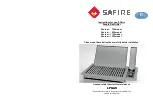
2S-2600/F/HD/HDF
Maintenance and Lubrication
Great Plains
| 195-440M | 2019-05-03
77
Chain Maintenance
Inspect and lubricate chains regularly. The slack of new
chains tends to increase during the first few hours of
operation due to seating.
Chain Slack
Check slack within the first 8 hours of operation and
tighten idlers as necessary.
Refer to Figure 85, which, for clarity, greatly
exaggerates slack, and omits the idlers.
1. Measure the span for allowable slack:
Locate the longest span of each chain (usually the
span which does not run through the idlers). The
ideal slack is between 2% and 4% of the span.
For example:
A slack of 1cm is appropriate for a 30cm span.
2. Measure the current slack :
Acting at a right angle to the chain span at the center
of the span, deflect the chain in both directions with a
force of about 9 lbs (4 kg). The slack is the distance
of the movement.
3. Adjust the idlers for ideal slack.
Whenever mounting a chain, make sure the clip at the
removable link is oriented to minimize snags.
Install clip with open end facing away from direction of
chain travel (shown by gray arrows in chain routing
diagrams).
Marker Maintenance
Marker Shear Bolt
The marker arm is attached to marker body with a shear
bolt , which is intended to fail if the marker strikes an
obstruction, allowing the marker to swing back around a
second bolt .
If the shear bolt breaks, replace it with an equivalent
3
18
-16x2in Grade 2 bolt (Great Plains part 802-266C). If
that size is not available in your local market, substitute
an M10x1.5 Class 5.8 metric bolt and nut.
NOTE:
Replacing the bolt with a lower grade, or smaller size,
can result in nuisance shears.
Equipment Damage Risk:
Replacing the bolt with a higher grade can result in marker
damage.
Figure 85
Measuring Chain Slack
27264
2
1
Figure 86
Chain Clip Orientation
26482
Figure 87
Marker Shear Bolt
15669
2
3
















































